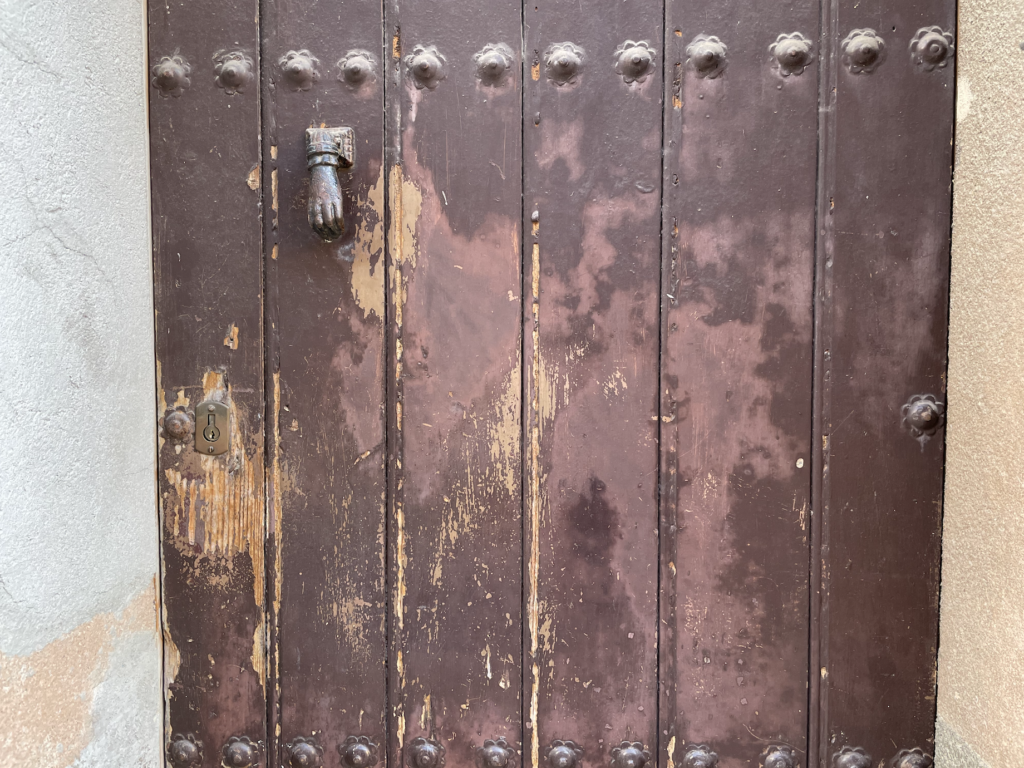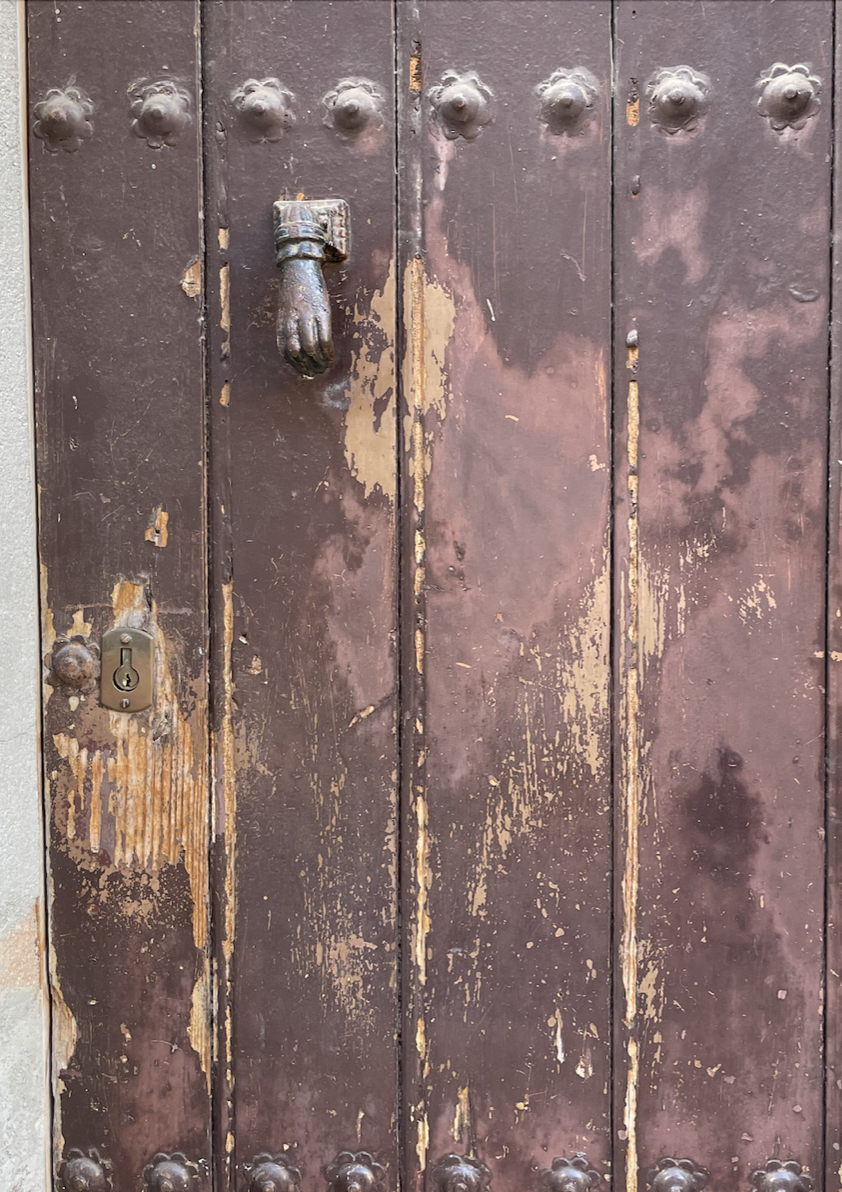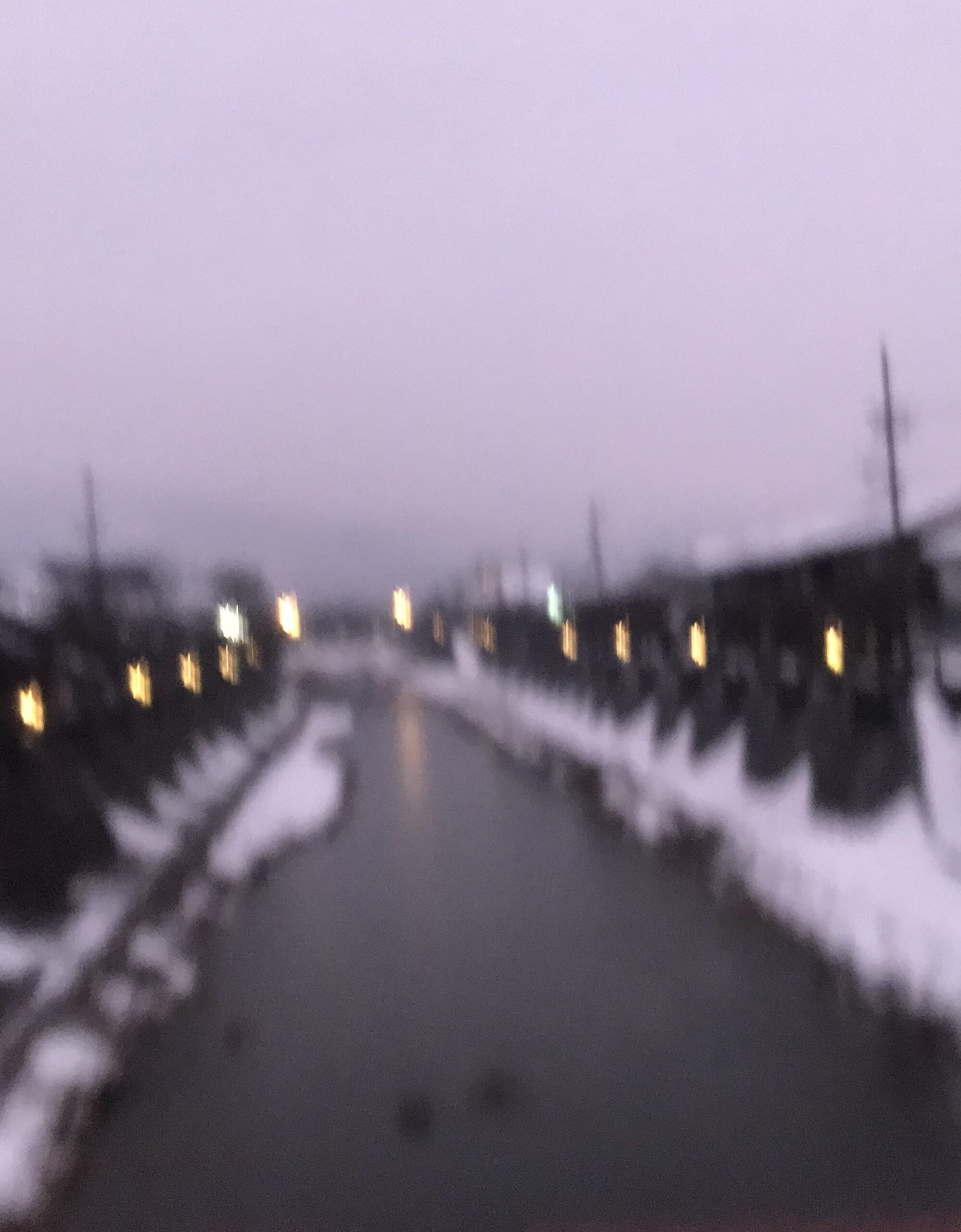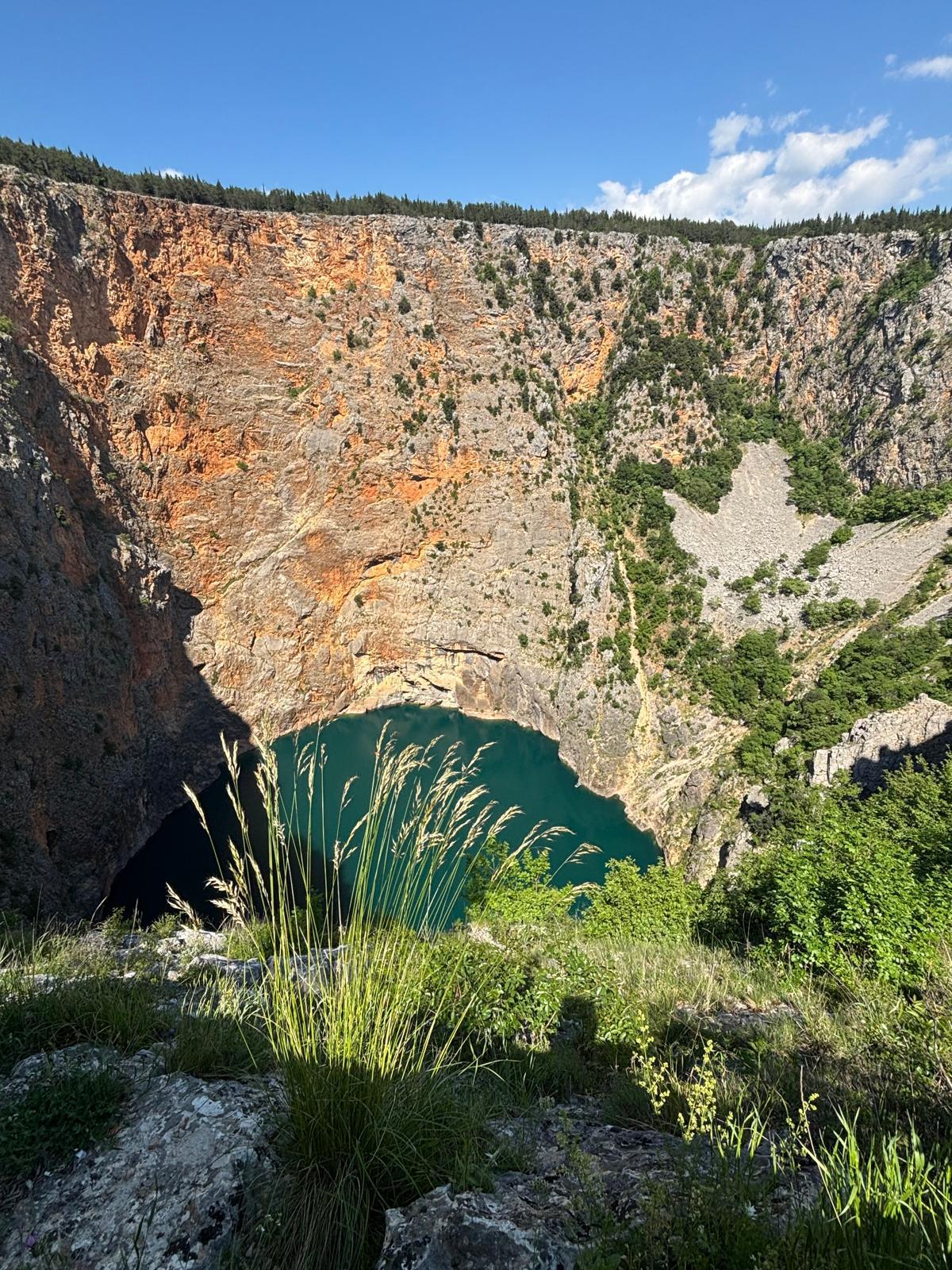
Catalonia
The sea has moved inland. Below the rectory on the hill, the fields and villages under the fog. In the first blue of the morning. The bell tower of the church in Lladó surfaces through it. It is a few minutes away by car. In Lladó the fog hangs in the streets, close to the ground. Each building in isolation within it. The old church, the locked doors: wood doors open onto metal doors that are molting their skin. The keyhole the size of an eye.
*
Late in the morning, to Castellfollit de la Roca, a medieval town on a basalt flow. Black buildings of volcanic stone built up to the sharp edge of the cliff. The cliff stone was black and composed of vertical columns. He said it is to do with the shape lava takes as it cools: it must contract as it hardens, both in height and in width. As it contracts in width it splits into vertical hexagons with cracks in between.
We walked down to get a view of the cliff from below. He said the cliff must have been cut out by two rivers. I asked how long this would have taken, he said he didn’t know. The mountains interlaced around us. He thought the caves nearby might be lava tubes. Very liquid lava, he said, burns away the earth underground as it moves, but flows through it, leaving behind a hole.
Horses were lying on their sides in the sun. A small green field surrounded by low stone walls.
Under the shadow of the basalt. In the small stream that had once carved the cliff I looked for fish. I saw weeds pressed down onto the bottom by the flowing water. He tried to look down along its length, to see where it ended.
*
The volcanoes here, he said, are small and very old. The Santa Margarida crater, an empty bowl, a tiny hermitage built in its centre. It is one small room, in the Romanesque style, a small round apse, the doors chained shut, small high windows, I lifted myself up on the ledge and looked through the grate. The inside dark and cold. A small table, a white altar cloth, white candles, a few statues. He stopped on the path carved down to the crater, the volcanic rocks in his palm, small and perfectly round.
*
The road between Oix and Beget is carved into the rock, it follows the curve of the mountain. Old goat paths, pilgrim paths, cow paths. There was a mountain ridge that seemed to fold over on top. Two types of stone, maybe, one softer than the other, he said, the hard one acts as a kind of hood to protect the soft from erosion. Or: it is rock pushed up on its side and the edge of the ridge marks the furthest angle it can tip without losing its shape to gravity. Or: the ridge is a spine.
The bare open rock at the roadside. He thought that here on this road had been an ancient underwater landslide. In some places you might see preserved the rubble of the landslide itself, he said, but you see here how the nearby force threw everything up into the water. The largest particles settled first, and the smallest remained suspended the longest. This creates an even layering in the rock, he said, from large at the bottom to small at the top. We stepped out of the car at the edge. It was quiet. To look out into the haze. Cow bells from the valley. Other mountains out ahead, the sun getting low. He bent down at the edge of the road and broke off a small piece of rock, put it in his mouth to taste it. He ground it between his fingers.
There were half-collapsed buildings at the sides of the road, the roof fallen in, stone walls still standing. Sometimes a small footpath and an old stone bridge, long driveways down to a stone house, smoke out the chimney, tarps over the roof, dogs.
*
Beget is low within the mountains, built straight onto the bedrock, the stone walls follow its shape. The bedrock forms the street. A small clear river runs through the village, a narrow stone footbridge high over the top of it. The church in the plaça is locked. An informational plaque notes that this is one of the only churches in the region not affected by the 1936 fire. On the plaque there is a small photo of its intact medieval interior. I tried the doors.
It was dark when we drove back down the mountain. Our eyes could not perceive the fire of the objects. The long dark tunnels through the inside of the mountain.
*
Cap de Creus, lunar, great aloes, quiet, the rock full of holes, he said, the soft parts are worn away, or, if water gets in the cracks it hollows them out, or sometimes, in other stone, the cracks in which the water moves undergo some kind of chemical reaction and become the hardest part: the rest is worn away around this web of hardened cracks.
At this point of the continent, the Pyrenees had once risen out of the sea.
We walked out on to the raw rocks of the cape. A rough dome of stone with the walls eaten away, a frame. On my knees. I looked at the ridges in the stone, tiny waves. He said some kind of intense pressure here had made even the smallest fibres of stone twist, bend, compress, contort, the sudden trauma. As though the rock were a body. I felt the surface with my hand.
He walked up to the highest point while I stayed low and watched the surface of the water.
*
The road between Sant Joan de les Abedesses and Olot. The yellow fields on either side of the road between small towns. Set back away from the road are ruins in the trees, on the hillsides, a flat circle of the valley, here alone once or twice, and once together. He flattens into some other shape. When the roots put down into a person shift. They moved into him and through him. Into whatever lay behind him.
*
An ancient city buried under layers of earth. The walls must be dug out. A ruined village at the remote top of a mountain. Santa Helena de Rodes. The cold glass air. Thin sheets of it. I thought about the marks people make on places. I wanted to see them with my hands. I stood inside the stone walls of a house and I knew it had been built by people but I could not feel them. Tiny fossilised sea creatures in the blocks of stone, at such an elevation. From this height, the land below, through the haze, looked like the sea. I wanted to stand inside the walls of the house with this man because I wanted the numinous past to triangulate something between myself and him. A shimmering hole. I walked out of the ruins toward the west. The church at my back. The air a pane of glass. The sun was setting. The castle up past the monastery a black silhouette. I thought: the sun has set in this place in this way as this town was first being built and inhabited. As pilgrims passed through this gate. Before this town was ever here. As pilgrims walked up the bare mountainside through the scrub. As these mountains formed from the ocean. Unnameable sunsets. If I had lived in this town I would be living in glass air, at the narrow peak of the mountain with the sun rising over the ocean and setting behind the Pyrenees. I would be living close. I could move in its skin. I could melt into the skin of the wind. There is not much land to move on here before it hits the sky. The air at night would thicken and settle. Blocks of thick glass, rippled and heavy. You can’t see through it.
*
The stone blocks of the Sant Llorenç monastery are full of shells. Each block cuts them to a different texture and angle. Once carried out from a quarry up the edge of the mountain. You insert the person you love in every scene. And that is what makes the space live. He puts his thumb in the photo against the fossils in the limestone, for scale.
Limestone and sandstone. Based on their order, he said, you can tell whether the sea level was rising or falling as the rock was formed. Sand at the shoreline.
Three naves, five apses, we climbed over the rubble and stood in the central nave, the foundation of a pre-Romanesque church beneath this one. Ancient ruins before this ruin was ancient. Empty arches. Open walls. The air was thin and there was frost on the ground. I wanted to touch him, to fill whatever was concave within him. To press myself to his body as through a doorframe. Lingering at the ecliptic mouth of it as though I could have known. I had pulled the Tower earlier that day. In Dali’s tarot, the figures on this card fall out of the tower headfirst through blue sky, as though they are floating through water to the floor of an ocean.
*
Santuari de la Mare de Déu del Mont. Sanctuary of the mother of god. Standing outside it. At five in the evening the bells began to ring. I thought I heard another bell ringing too, from some unseen village below but he said it was an echo. He walked over the edge to hear it.
I wanted him in every photograph. How to frame a vast and empty landscape. To try to put love into the landscape, into the frame. In these mountains devotion and the love of god saturate the ground. The sun, when it is under the earth, is inside the earth. Radiating heat through the ground. I wanted love to pierce the arches of my feet. I wanted love to radiate from my hands and my eyes, the eye of the camera, that invisible fire.
Until he felt himself on fire.
*
How two bodies are positioned together. What is extruded when seams of two halves are sealed. Understanding tilts on an unstable axis. If I could learn to love that motion instead of experiencing a kind of vertigo. The fluid inside the ears. The small and private ocean. The ear is a cave. Resonant and still. In silence still felt. The unknown geology of another body.
To be inserted somehow more deeply into the landscape. A slit cut into it, to enter, instead of being placed on its surface. A cut made at the outline of a mountain to move into.
There are churches here and locked doors. When I could peer in through a grate or window, I saw the thickness of the walls. These are not fibrous gothic structures. Romanesque. Solid.
Here.
The nave.
Its angles.
A round apse.
High up, a few windows.
The dark interior.
The impenetrable round walls. Yet I wanted to see every church I could. Stay close to it. Try the door. Look at the latch. Sometimes in the shape of a reptile. The huge hinges and keyhole. I would shine a light through.
Hildegard Hansen is based in Providence, Rhode Island. She received her MFA in Literary Arts from Brown University and has taught at Brown and at the Rhode Island School of Design.




